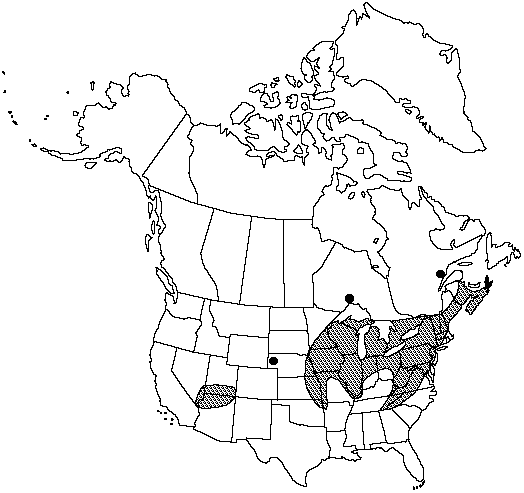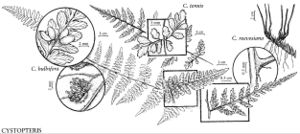Difference between revisions of "Cystopteris tenuis"
6: 264. 1827.
FNA>Volume Importer |
FNA>Volume Importer |
||
| Line 22: | Line 22: | ||
}}<!-- | }}<!-- | ||
| − | --><span class="statement" id="st- | + | --><span class="statement" id="st-undefined" data-properties=""><b>Stems </b>creeping, not cordlike, internodes short, beset with old petiole bases, hairs absent; scales tan to light brown, lanceolate, radial walls thin, luminae tan. <b>Leaves</b> monomorphic, clustered at stem apex, to 40 cm, nearly all bearing sori. <b>Petiole</b> dark at base, mostly green to straw-colored distally, shorter than or nearly equaling blade, base sparsely scaly. <b>Blade</b> lanceolate to narrowly elliptic, 1(–2)-pinnate-pinnatifid, widest at or just below middle, apex short-attenuate; rachis and costae lacking gland-tipped hairs or bulblets; axils of pinnae lacking multicellular, gland-tipped hairs. <b>Pinnae</b> typically at acute angle to rachis, often curving toward blade apex, margins crenulate; proximal pinnae pinnatifid to pinnate-pinnatifid, ± equilateral, basiscopic pinnules not enlarged; basal basiscopic pinnules sessile, base cuneate to obtuse, distal pinnae ovate to narrowly elliptic. <b>Veins</b> directed into teeth and notches. <b>Indusia</b> ovate to cup-shaped, without gland-tipped hairs. <b>Spores</b> spiny, usually 39–50 µm. <b>2n</b> = 168.</span><!-- |
-->{{Treatment/Body | -->{{Treatment/Body | ||
| + | |phenology=Sporulating summer–fall. | ||
|habitat=Mostly on shaded rock and cliff faces but also occasionally on forest floors | |habitat=Mostly on shaded rock and cliff faces but also occasionally on forest floors | ||
|elevation=0–2800 m | |elevation=0–2800 m | ||
| Line 45: | Line 46: | ||
|basionyms=Nephrodium tenue | |basionyms=Nephrodium tenue | ||
|family=Dryopteridaceae | |family=Dryopteridaceae | ||
| + | |phenology=Sporulating summer–fall. | ||
|habitat=Mostly on shaded rock and cliff faces but also occasionally on forest floors | |habitat=Mostly on shaded rock and cliff faces but also occasionally on forest floors | ||
|elevation=0–2800 m | |elevation=0–2800 m | ||
| Line 52: | Line 54: | ||
|publication year=1827 | |publication year=1827 | ||
|special status= | |special status= | ||
| − | |source xml=https://jpend@bitbucket.org/aafc-mbb/fna- | + | |source xml=https://jpend@bitbucket.org/aafc-mbb/fna-data-curation.git/src/9216fc802291cd3df363fd52122300479582ede7/coarse_grained_fna_xml/V2/V2_663.xml |
|genus=Cystopteris | |genus=Cystopteris | ||
|species=Cystopteris tenuis | |species=Cystopteris tenuis | ||
| − | |||
| − | |||
| − | |||
| − | |||
| − | |||
| − | |||
| − | |||
| − | |||
| − | |||
| − | |||
| − | |||
| − | |||
| − | |||
| − | |||
| − | |||
| − | |||
| − | |||
| − | |||
| − | |||
| − | |||
| − | |||
| − | |||
| − | |||
| − | |||
| − | |||
| − | |||
| − | |||
| − | |||
| − | |||
| − | |||
| − | |||
| − | |||
| − | |||
| − | |||
| − | |||
| − | |||
| − | |||
| − | |||
| − | |||
| − | |||
| − | |||
}}<!-- | }}<!-- | ||
-->[[Category:Treatment]][[Category:Cystopteris]] | -->[[Category:Treatment]][[Category:Cystopteris]] | ||
Revision as of 14:25, 27 July 2019
Stems creeping, not cordlike, internodes short, beset with old petiole bases, hairs absent; scales tan to light brown, lanceolate, radial walls thin, luminae tan. Leaves monomorphic, clustered at stem apex, to 40 cm, nearly all bearing sori. Petiole dark at base, mostly green to straw-colored distally, shorter than or nearly equaling blade, base sparsely scaly. Blade lanceolate to narrowly elliptic, 1(–2)-pinnate-pinnatifid, widest at or just below middle, apex short-attenuate; rachis and costae lacking gland-tipped hairs or bulblets; axils of pinnae lacking multicellular, gland-tipped hairs. Pinnae typically at acute angle to rachis, often curving toward blade apex, margins crenulate; proximal pinnae pinnatifid to pinnate-pinnatifid, ± equilateral, basiscopic pinnules not enlarged; basal basiscopic pinnules sessile, base cuneate to obtuse, distal pinnae ovate to narrowly elliptic. Veins directed into teeth and notches. Indusia ovate to cup-shaped, without gland-tipped hairs. Spores spiny, usually 39–50 µm. 2n = 168.
Phenology: Sporulating summer–fall.
Habitat: Mostly on shaded rock and cliff faces but also occasionally on forest floors
Elevation: 0–2800 m
Distribution

N.B., N.S., Ont., Que., Ark., Ariz., Conn., Del., Ill., Ind., Iowa, Kans., Ky., Maine, Md., Mass., Mich., Minn., Mo., Nebr., Nev., N.H., N.J., N.Y., N.C., Ohio, Okla., Pa., R.I., Tenn., Utah, Vt., Va., W.Va., Wis.
Discussion
Long recognized as Cystopteris fragilis var. mackayi, C. tenuis was returned to species status by R. C. Moran (1983b). It is probably an allotetraploid originating from C. protrusa and an extinct diploid related to C. fragilis (C. H. Haufler 1985; C. H. Haufler and M. D. Windham 1991).
Cystopteris tenuis is common in eastern North America and less frequent at the northern and western perimeter of its range. In the center of its distribution (Minnesota, Iowa, Illinois, Wisconsin, Indiana, Ohio, Pennsylvania), the narrow, elliptic pinnae angled toward the blade apex and the rounded teeth make C. tenuis relatively distinct from C. fragilis and C. protrusa (although the early season, sterile leaves of C. protrusa often resemble those of C. tenuis). In the west and especially in the northeast, C. tenuis and C. fragilis are difficult to distinguish. For the most part, C. fragilis is confined to higher latitudes and elevations than C. tenuis, but the two species can be sympatric and occasionally form sterile tetraploid hybrids. Cystopteris protrusa and C. tenuis are infrequently sympatric, but where they are, sterile triploid hybrids can occur. Hybrids between C. tenuis and C. tennesseensis are recognized as C. × wagneri (R. C. Moran 1983). Hybridization between C. tenuis and C. bulbifera has also been reported (R. C. Moran 1982b). This hybrid, C. × illinoensis R. C. Moran, is known only from the type and needs to be studied further.
Selected References
None.
